Mt. Carrigain and Vose Spur Loop with Bushwhack
| Destinations: | Mt. Carrigain (4700’), Signal Ridge (4420'), Vose Spur (3862'), Duck Pond (3050') | |
| Trails: | Signal Ridge Trail, Carrigain Notch Trail, Bushwhack | |
| Region: | NH - Central East White Mountain National Forest, Carrigain Region | |
| Location: | Livermore, NH | |
| Rating: | Difficult | |
| Features: | Summits, views, ledges, brooks, cascades, fire tower, 4000-footer, orienteering/route finding, loop hike, backpack | |
| Distance: | 11.3 miles | |
| Elevation Gain: | 4600 feet (cumulative) | |
| Hiking Time: | Actual: 13:30 Typical: 12:10 | |
| Outing Duration: | See the Mileage Splits section for daily estimates | |
| Season: | Spring | |
| Hike Date: | 06/05/2009 (Friday) (2 days) | |
| Last Updated: | 10/02/2009 | |
| Weather: | Mostly sunny, 50-70 degrees | |
| Author: | Bill Mahony | |
| Companions: | Van, for the second day from Vose Spur to finish |
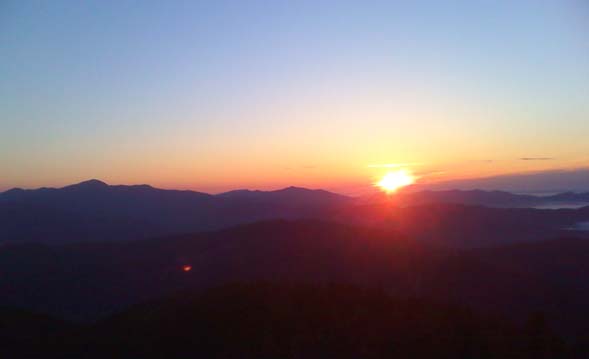 |
Route Summary
This a two-day loop backpack. The first day follows Signal Ridge Trail up Mount Carrigain which offers fantastic views both from Signal Ridge and from the mountaintop fire tower.
The second day is almost entirely off-trail and visits the wooded summit of Vose Spur and then Duck Pond, following Whiteface Brook for most of the return route.
Day 1: Signal Ridge and Mount Carrigain
- From the parking area on Sawyer River Road, start on Signal Ridge Trail.
- After just 0.2 mile you will cross Whiteface Brook which may be difficult at high water. If it seems too dangerous, return to the parking lot and bushwhack along the stream's south bank until running back into Signal Ridge Trail.
- From the first brook crossing, follow Signal Ridge Trail for 1.5 miles which will bring you to a trail junction.
- Bear left, still following Signal Ridge Trail while Carrigain Notch Trail goes off to the right.
- Continue for another 2.8 miles, climbing steeply after the first mile.
- You will arrive at Signal Ridge, an open area with great views, especially to the nearby cliffs of Mount Lowell.
- Continue on Signal Ridge Trail for a final 0.5 mile which will bring you to the mostly wooded summit of Mount Carrigain. Climb the fire tower to get fabulous views.
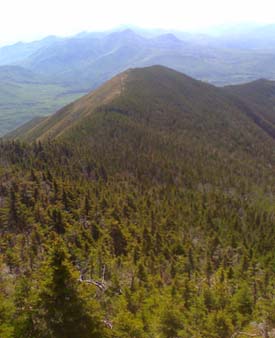 |
Day 2: Vose Spur, Duck Pond, and Whiteface Brook Bushwhack
- Be aware that most of today's hike involves bushwhacking which is much slower than regular hiking. There is thick overgrowth to push through, a talus slope, and many blowdowns.
- From the summit area of Mount Carrigain, follow a compass bearing to the northeast for about a mile to reach Vose Spur. You will reach an unnamed spur before reaching Vose which is wooded but has a summit canister with a log book.
- Still using a compass, continue in a northeasterly direction which will cause you to intersect with Carrigain Notch Trail after about 0.5 mile.
- Option: If you want to cut the hike short by about 2 miles and go the rest of the way on trails, turn left (south) onto Carrigain Notch Trail, follow it for about 2 miles which will bring you to the junction with Signal Ridge Trail. Turn left onto Signal Ridge Trail and follow that for 1.7 miles back to the parking area on Sawyer River Road.
- If you want to continue with the bushwhack, look carefully for the landmarks of Mounts Anderson and Lowell. Your goal is to reach the col between these two points. You may have to walk north on Carrigain Notch Trail for a bit before veering easterly towards the col and Duck Pond. You should pass through the col, then reach Duck Pond after about 1.0 mile.
- Option: You may wish to summit (still bushwhacking) Mount Anderson (to the north) or Mount Lowell (to the south) from the col if you have time. This option is best done as part of a three-day backpack as hiking time increases greatly when bushwhacking over rough terrain.
- From Duck Pond, get to its eastern shore from which Whiteface Brook flows. Follow Whiteface Brook for about 3.0 miles which will bring you to Signal Ridge Trail at a point that you passed by on the prior day.
- Turn left and follow Signal Ridge Trail for 0.8 mile back to the parking area on Sawyer River Road.
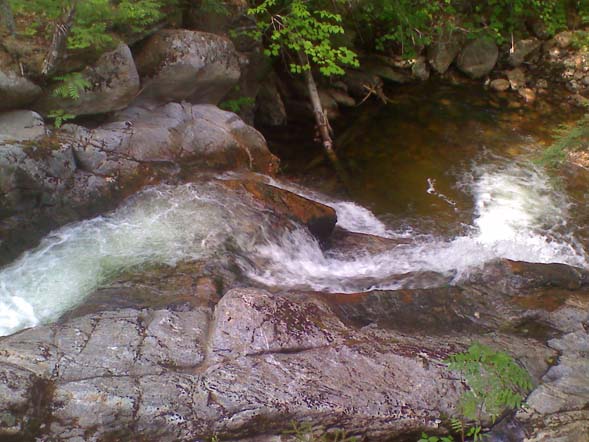 |
Day 1: Signal Ridge and Mount Carrigain
| Place | Split Miles |
Total Miles |
||
|---|---|---|---|---|
| Signal Ridge Trailhead (1480') | 0.0 | 0.0 | ||
| Jct. Signal Ridge Trail / Carrigain Notch Trail (1900') | 1.7 | 1.7 | ||
| Signal Ridge (4420') | 2.8 | 4.5 | ||
| Mt. Carrigain summit (4700') | 0.5 | 5.0 |
Daily Rating: Moderate/Difficult
Daily Elevation Gain: 3250 feet (cumulative)
Daily Typical Hiking Time: 4:10
Daily Typical Outing Duration: 6:00
Day 2: Vose Spur, Duck Pond, and Whiteface Brook Bushwhack
| Place | Split Miles* |
Total Miles* |
||
|---|---|---|---|---|
| Mt. Carrigain summit (4700') | 0.0 | 0.0 | ||
| Vose Spur summit (3862') | 1.0 | 1.0 | ||
| Carrigain Notch Trail (2400') | 0.5 | 1.5 | ||
| Duck Pond (3050') | 1.0 | 2.5 | ||
| Jct. Whiteface Brook / Signal Ridge Trail (1750') | 3.0 | 5.5 | ||
| Signal Ridge Trailhead (1480') | 0.8 | 6.3 | ||
| * mileage is approximate | ||||
Daily Elevation Gain: 1350 feet (cumulative)
Daily Typical Hiking Time: 8:00
Daily Typical Outing Duration: 11:00
|
|
|||||
|
|
|||||
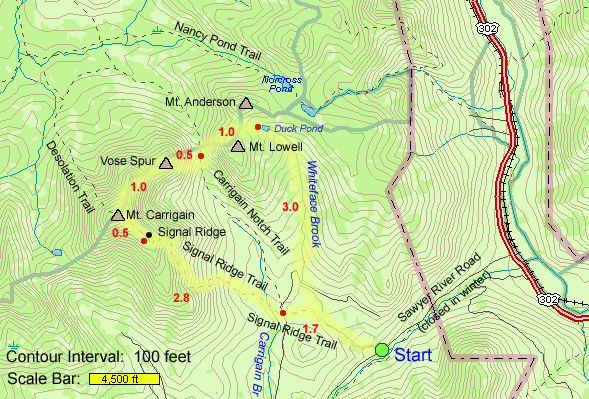
Trail Guide
This two-day trail report covers an ascent to Mount Carrigain, stargazing and watching the sun come up from its fire tower, and then a challenging bushwhack to Vose Spur and Duck Pond, returning via Whiteface Brook. The original plan was also to summit the trailless Mounts Anderson and Lowell but that proved to be too difficult given the time I had.
Since this is a long trip report, I've divided it into sections:
Signal Ridge and Mount Carrigain
Stargazing and Sunrise
Vose Spur, Duck Pond, and Whiteface Brook Bushwhack
Signal Ridge and Mount Carrigain
I pulled up to the Signal Ridge Trail parking lot Friday afternoon around 3:00 p.m. and started up to Mount Carrigain under clear (or so I thought) and cool skies. The beginning of Signal Ridge Trail was easy to follow and the forest was very green and a bit buggy. There are a few stream crossings, but they were fairly low water and easy to cross on the rocks and logs in them. Along the start of the trail there are several spots that had some nice cascades. I stopped to take some pictures and thought that these would make a nice place to swim in the dead heat of the summer. The water was not icy cold down here, but still quite cool. I met a few hikers coming down the mountain with the last one passing me by at around 4:00 p.m.
Signal Ridge Trail for the first 1.7 miles is easy, covering wide, smooth and fairly level terrain. Just before the junction with Carrigain Notch Trail there is supposedly an old road that crosses the trail. It was barely noticeable this late in the spring and I thought that following it would be a minor bushwhack. Just after the trail junction (still on Signal Ridge Trail) I saw a nice quiet beaver pond with some sort of fish life in it, but I couldn't see them when I got close.
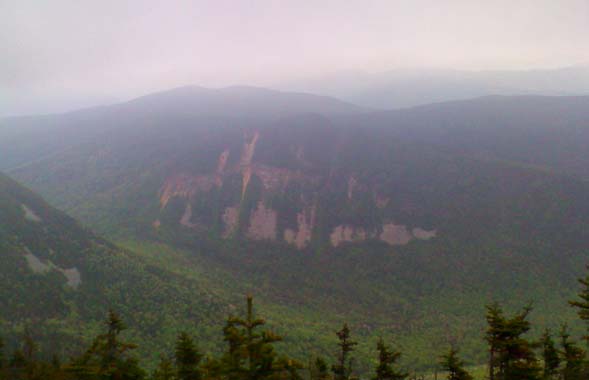 |
Signal Ridge makes the trail rise more steeply and the streams start to get a little more meager. I was working harder on the steep sections and I realized that I still had to climb 2,000 feet to reach the summit. The trail provided some nice views of Mount Lowell as I went up. The terrain was a mix of pine, birch, beech and varied low plants. I filled my water bottle at some skimpy water sources and the sticks and mud in my bottle as I neared the top of the ridge made me nervous about water early in my trip. I had read trip reports of this mountain and I figured that the well "at the top" would be enough for me to refill regularly during my stay there.
As I topped the ridge I thought that I was making the summit and I was puzzled by the lack of a fire tower. It turns out that I had just made it to the top of Signal Ridge – still a half-mile from the summit. Well, the ridge itself was a great respite anyway. The views to all sides were impressive. This was like Franconia Ridge, but without the traffic and with pristine views all around (no roads, houses, buildings etc.). I took some great pictures of the local weather pattern that you hear about but rarely see. The view down and outward at my altitude (4,420 feet) was great and probably about twenty miles, but the clouds just 100 feet over my head were converging from the east and west onto the summit cone of Carrigain. The clouds were then blowing over the summit at 20–30 mph... a very cool effect. The scene looked a bit like something from movies of Arthurian England and the hills around Camelot; just a soundtrack was needed to make it complete.
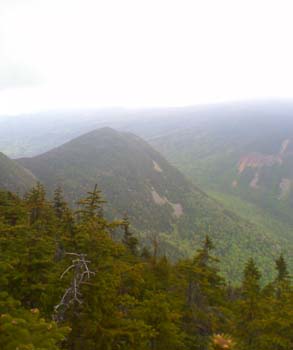
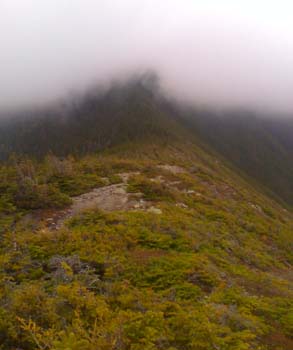
|
I stayed up on the ridge and noticed that many rocks on the high ridge had recently been "dislodged" and were gone. Clearly people were throwing rocks down the steep, vegetated slope. The little kid in me thought that this might be fun, but I'd hate to be the person bushwhacking up that side (it was steep, but it could be done). It probably isn't good for the vegetation either, so I resisted. I could see the trail continuing on up the summit, but it quickly disappeared in clouds. Just after re-entering the trees at the base of the summit it looked like the trail went in four different directions... this is where I found the well. I used it to fill my water bottle with clear water, but was disappointed because I knew that the summit tower and my campsite for the night would not be very close to this spot. The remaining trail to the summit was pretty as it passed through a large open mossy area just before the top.
The tower at the summit was shrouded in clouds and visibility at the top was poor looking straight out. You could catch some glimpses looking down to Signal Ridge and Vose Spur, but not much else.
I got to the summit around 7:30 p.m. and the temperature had dropped below 50 degrees so I cooled (and dried) quickly in just shorts and a poly T-shirt. I found a small spot well off the trail (in the direction of my planned bushwhack to Vose Spur) and set up my tent, then I donned my gloves and hat and went up on the tower. Visibility was 100 feet or so... no worse than a mild fog on the Maine coast. Oh well, I went back to the tent, read for a few minutes, checked the map for the next part of the hike and went to bed.
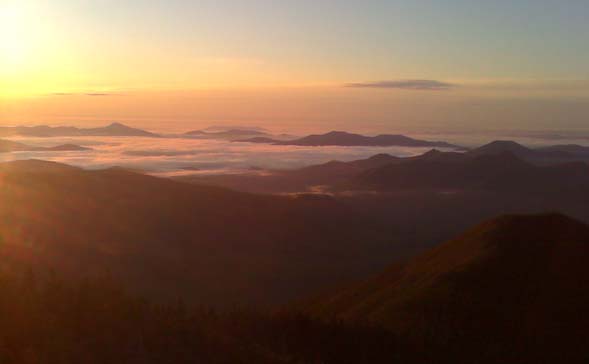 |
Stargazing and Sunrise
Now comes the glorious part of the trip. I woke up at 2:00 a.m. with light shining into my tent. The moon was nearly full and the clouds were nearly gone. I was going to sleep a bit more (until 4:00 a.m.), but slowly decided to gear up and see what the Milky Way looked like on that night. I was not disappointed. I got on the tower by 2:30 a.m. and did not leave until 6:00 a.m. I walked around on the platform for a bit then lay down and looked up at the sky for some time. I managed to see one shooting star and the Milky Way was visible as the moon began to set and fall behind clouds far down in the southwestern sky.
The view was awesome the whole time, first in the moonlight, then the early dawn and then bright in the full daybreak at 5:00 a.m. The light started almost directly over Mount Washington and rose just to the east (to the right of Mount Washington from my perspective). The colors, the low clouds over Glen, New Hampshire, and the views to the south were awesome. I had the entire summit to myself all morning. I started taking pictures as soon as my camera would pick up the ambient light, which turned out to be at 3:30 a.m. By 4:00 a.m. I could see the entirety of the Whites (it seemed) and I pulled out my map to try to identify the landmarks around me. Mount Hale was directly north of my view so I used it frequently to orient the map and identify peaks. Visibility had to be pretty good because at 4:30 a.m. I could positively identify Waterville Valley Ski Area.
Sunrise was officially at 5:04 a.m. and I got some great pictures. I would guess that sunrise at North Hancock would provide a sunrise right over Mount Washington at this time of year... I'll have to try that hike in the next few weeks. I took over fifty pictures between my phone and my camera for the morning, which for me is a ton (I usually just point, shoot, and move on after a few seconds).
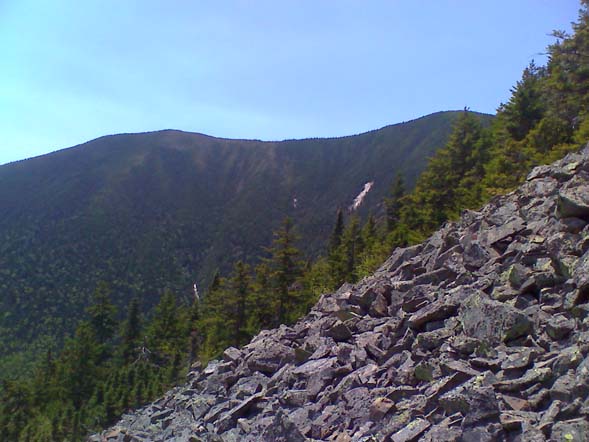 |
Vose Spur, Duck Pond, and Whiteface Brook Bushwhack
At 6:00 a.m. I took a nap until about 8:30 a.m., packed up, and started my bushwhack over to Vose Spur. The whack was not too hard or thick and I saw a patch of snow on the north branch of Carrigain. Going downhill definitely made this part easier since I could use gravity to "push" forward. I did get beaten up a bit. This was my first trip off-trail in the middle of nowhere so I was a bit wary. I have experience with orienteering and I use charts and a compass out on the boat (don't use GPS at all), so I should have been comfortable.
I used some of the open spots to confirm that I was heading toward the correct peak and away from the Carrigain summit. I wasn't really paying close enough attention though. I ascended a sub-peak on the northeast side of Carrigain and I should have realized that this was not Vose Spur, but I had lost track of the altitude and didn't check the map closely enough to realize that I needed to go much farther down, and then up to be on Vose Spur. I saw a rock cairn, but could not find a canister at the summit... oh well I would just press on down the "spur" until I hit Carrigain Notch Trail... it's only a short bushwhack!?
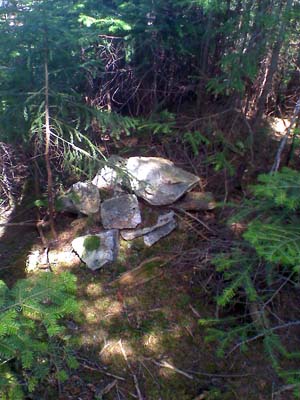 |
After a bit of climbing I saw a small herd path that crossed my track and seemed to lead to the summit so I followed it up 50 yards or so. At a small clearing I saw the canister for the summit of Mount Lowell? Okay so it said Vose Spur! Groaning, I realized that I had completely misread where I had been. Fortunately I had trusted my maps and compass and continued in the direction I knew that there would be a trail. At noon I sat at the summit, let the container contents dry out – all the stuff inside was soaked – and had lunch. After a messy PB and Fluff sandwich (note to self: Fluff turns into liquid when it gets warm) I signed the log book and put everything back into the container. I shouldered my pack and started down the herd path, this time truly heading towards Carrigain Notch Trail.
I met a whole crew at the top of Vose Spur from Views From The Top (VFTT), who told me that the herd path was easy to follow until the talus field and then somewhat dicey from there (but not thick). One of the group had a GPS map on his website, which I had printed up as a "why not" just in case. He was tickled that people were using his map (I was the second one that day). I continued down the path, but lost the trail after a short time. The woods were pretty open on the southeast facing slope and I didn't mind.
I caught the edge of a large talus field and used it to wind toward the south (not the way I wanted to go) and down. At this point I joined up with Van from VFTT who also wanted to try for the summits of Mounts Anderson and Lowell. By 2:00 p.m. we were on Carrigain Notch Trail and I figured that we could make the col between Anderson and Lowell within 1-1/2 hours. But it took us three hours to get to the col between the 3,740-foot hills. The entire whack at this point was steep and thick. We followed our compasses, but due to thickness we didn't always head directly on our course. We could see the summit of Anderson and Vose Spur and they looked far uphill to us. We ended up coming up the north side of Lowell a bit, but not so much that we missed the col. There was some muddy water in the col, but I needed a refill of my bottle since I had already drained one bladder and had been working on the second for an hour or so (at a pretty good rate).
At that point I called it a day (mentally anyway – it looked so easy on the map). I was beaten badly by the whack to Vose and then up to the col and we were running out of time. I suggested we push on to Duck Pond and re-evaluate from there. When we got to Duck Pond Van saw some flowers that he was looking to photograph and they were beautiful, but I was too pooped to be enjoying much anymore. I did get some pictures, but was looking forward to being back at the car. I considered camping right at Duck Pond, which I had plenty of food, clothing, and water to do, but Van was only prepared for a day hike so I pressed on. Van was in better shape, but he could see that hitting summits through this thickness of growth and this late hour was just not going to happen. We called it a day and decided to head down instead of up.
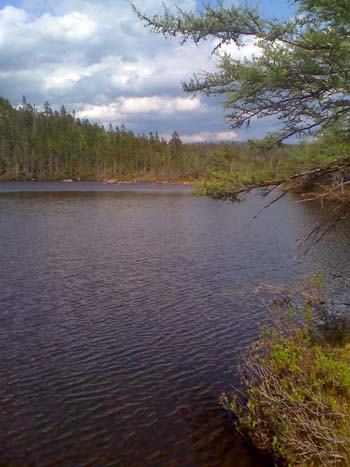 |
Recap: The bushwhack from Vose Spur is best done with a good map and compass because other than a short section of Carrigain Notch Trail, the undergrowth is extremely thick, covered with many large blowdowns and is very steep even going up to the col between Mounts Anderson and Lowell. I need to figure out some way to gauge my distance traveled over varied conditions. I do okay on open trail, but bushwhack speed uphill, downhill and thick vs. thin forest makes a huge difference.
New resolution: No bushwhacking over one mile in any given day... there are plenty of trails out there to explore for that kind of work. I will long remember my night on Carrigain and I'm looking forward to doing it again this week.
Gear Notes: The bushwhack really gave my gear a beating, but most of it held up well. I lost my raincoat (Stearns) when I was doing a thick section. There are two implications: one is that I need a new raincoat and the other is that my backpack can come open (top pocket) when it is getting scraped repeatedly by trees. Coleman Max sleeping pad: got a second one after the first one leaked during my trip on the Western Pemi hike and this one leaked too. Cheap gear just doesn't seem to hold up. I can't return it because it got a big rip in it during the bushwhack.
I wore wool socks instead of the poly ones for the bushwhack and got hot spots and the start of blisters because the extra padding allowed my feet to move within the boot during the extreme gripping needed to hop rocks, climb blowdowns and punch through vegetation without seeing my footfalls. I will reserve the wool for cold weather hiking or backup on open trails. The tent with the fly worked well (first time using the fly) and set up easy in the evening. The new map-type compass from Wal-Mart was adequate for the task of orienteering and I was able to get where I wanted.
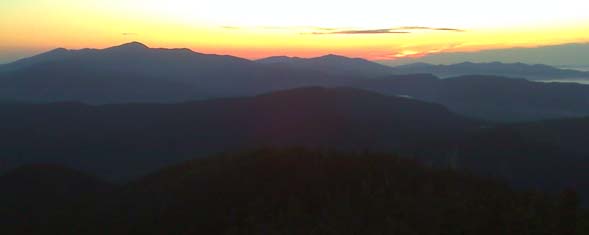 |
|
|
|||||
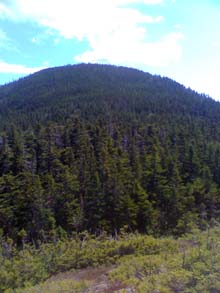 |
|
|||||
|
|
|||||

The trailhead for Signal Ridge Trail is located in Livermore, New Hampshire on Sawyer River Road, off of Route 302.
From the West:
- From the junction of Routes 3 and 302 in Carroll (Twin Mountain), follow Rt. 302 East for approximately 19 miles.
- Turn right onto Sawyer River Road (FR 34).
- Follow Sawyer River Road for 2.0 miles.
- Signal Ridge Trail is on the right just before a bridge over Whiteface Brook. Parking is on the left just after the bridge.
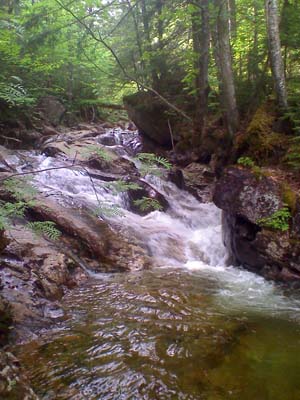 |
From the East:
- Follow Rt. 302 West.
- Turn left onto Sawyer River Road (FR 34) which is located about 4 miles west of Bear Notch Road (also on the left) in Bartlett.
- Follow Sawyer River Road for 2.0 miles.
- Signal Ridge Trail is on the right just before a bridge over Whiteface Brook. Parking is on the left just after the bridge.
Winter: Sawyer River Road is closed during winter.
Check out the White Mountain National Forest's road status page for the most up-to-date information on road closures.
Other Notes
WMNF Recreational Pass
A parking permit is required to park at White Mountain National Forest trailheads and parking areas. You can purchase a WMNF permit from the forest service and other vendors and can also pay-by-the-day using self-service kiosks located in many parking areas.
For more information on parking passes please refer to the White Mountain National Forest website.
Rates:
- $5 per day
- $30 for a year-long pass
- $40 for a year for a household
More Mt. Carrigain, Signal Ridge, and Vose Spur Trail Reports
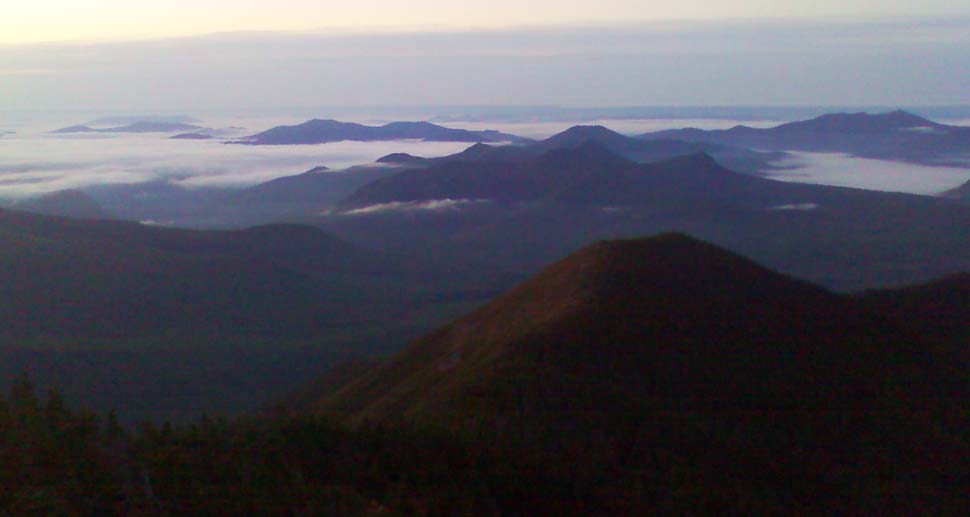 |
Website by
![]() LeapfrogProgramming.com
LeapfrogProgramming.com
© 1998-2025
![]()
| The information on this site may freely be used for personal purposes but may not be replicated on other websites or publications. If you want to reference some content on this site, please link to us. |



